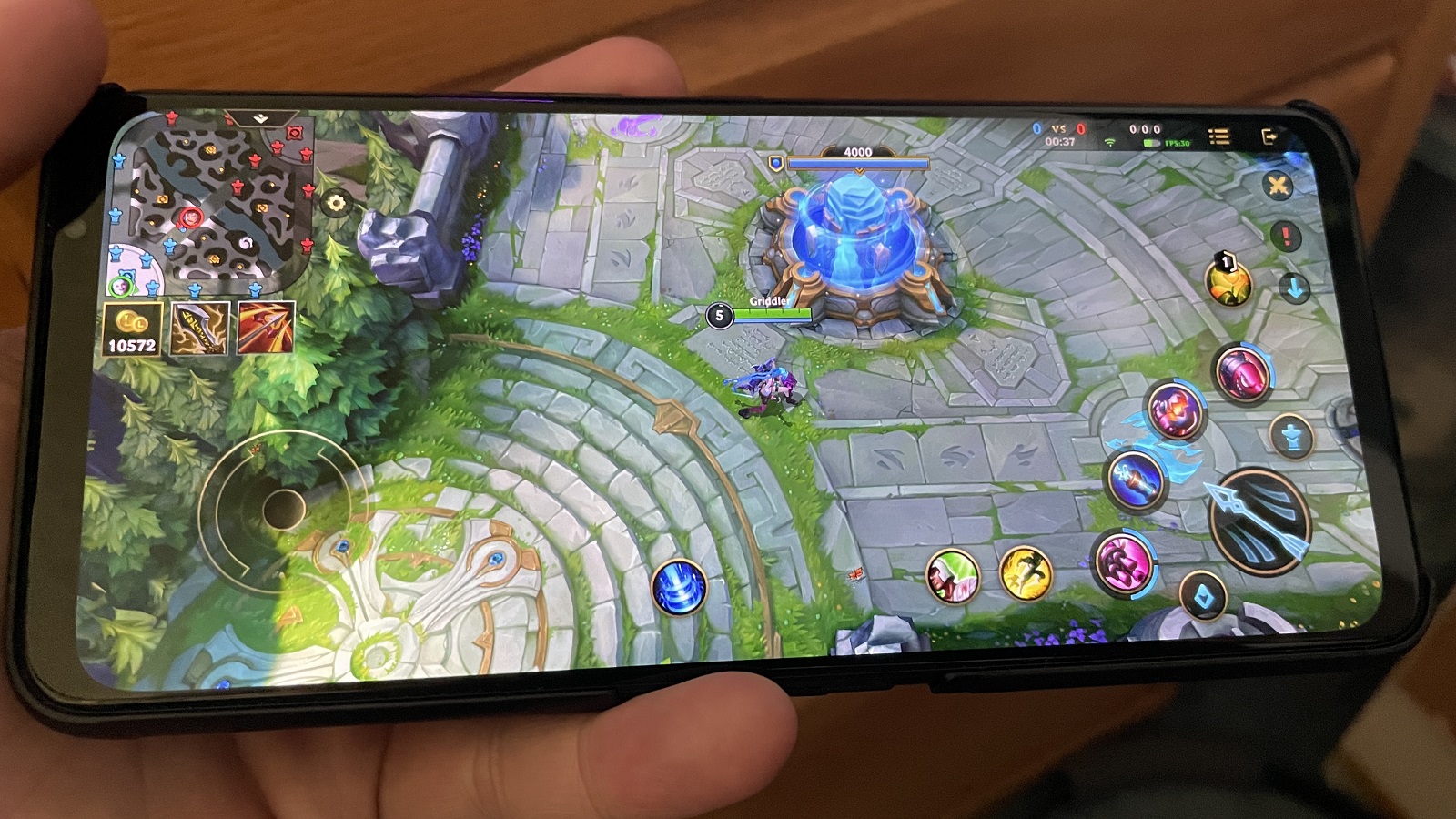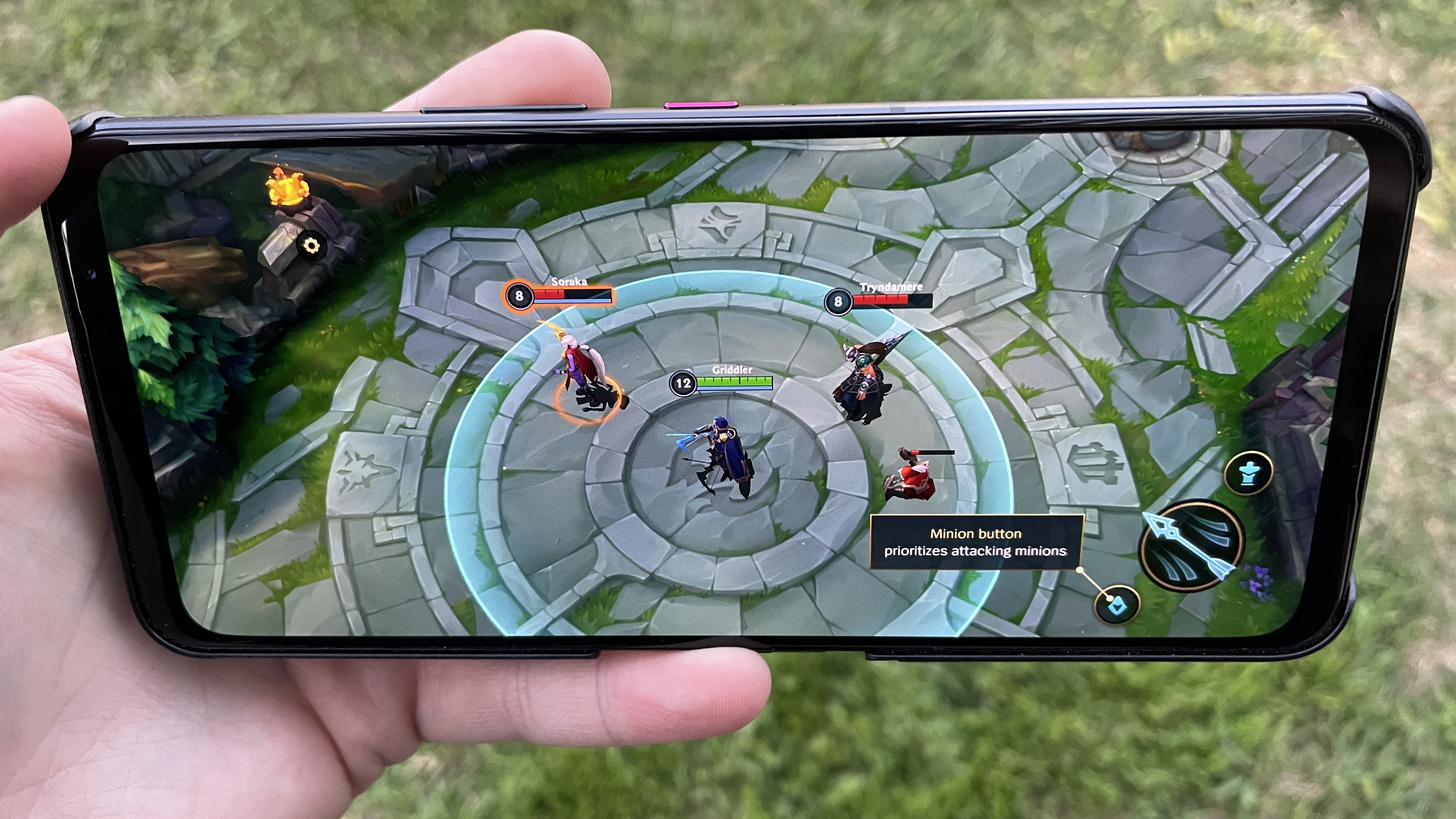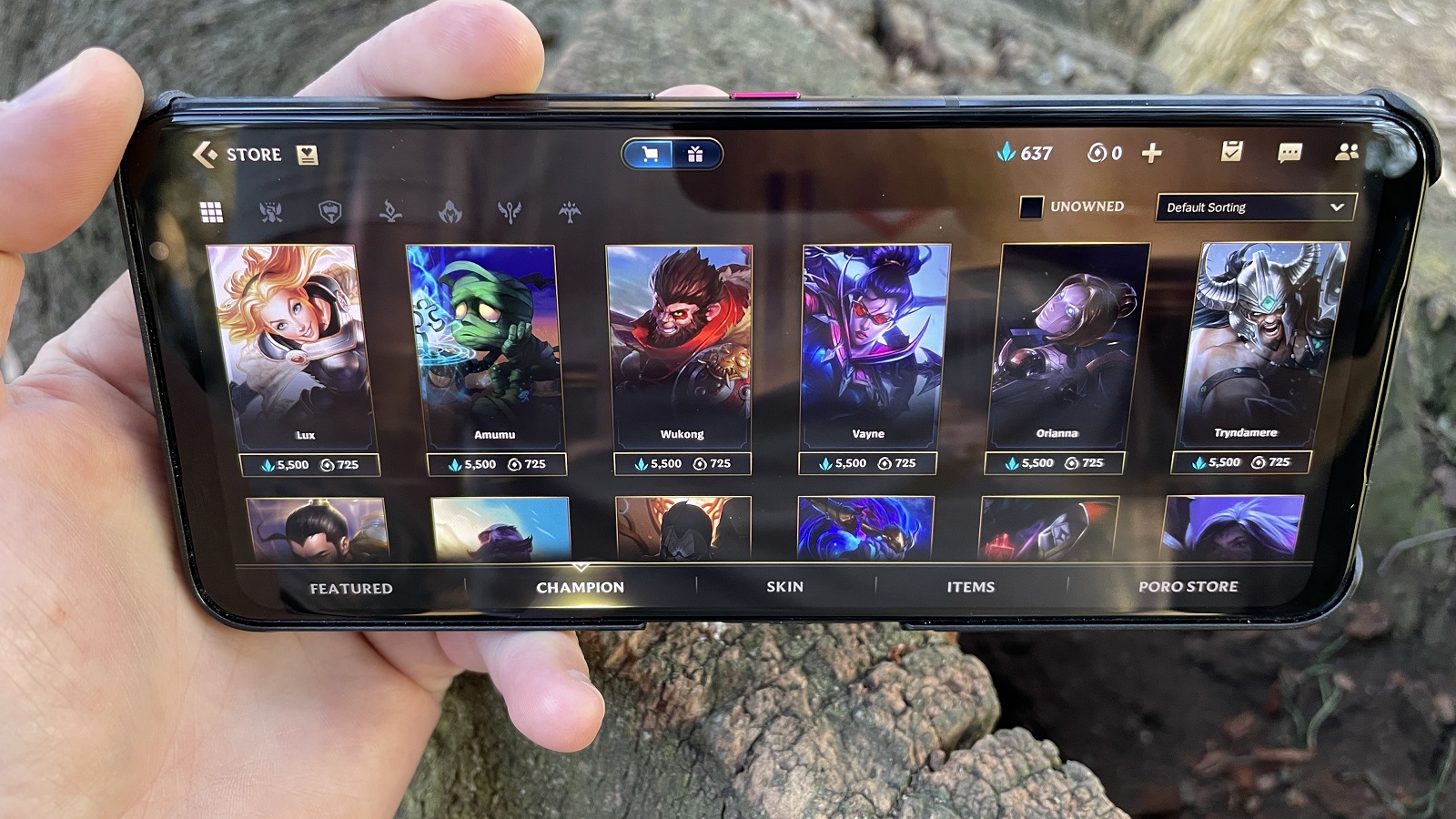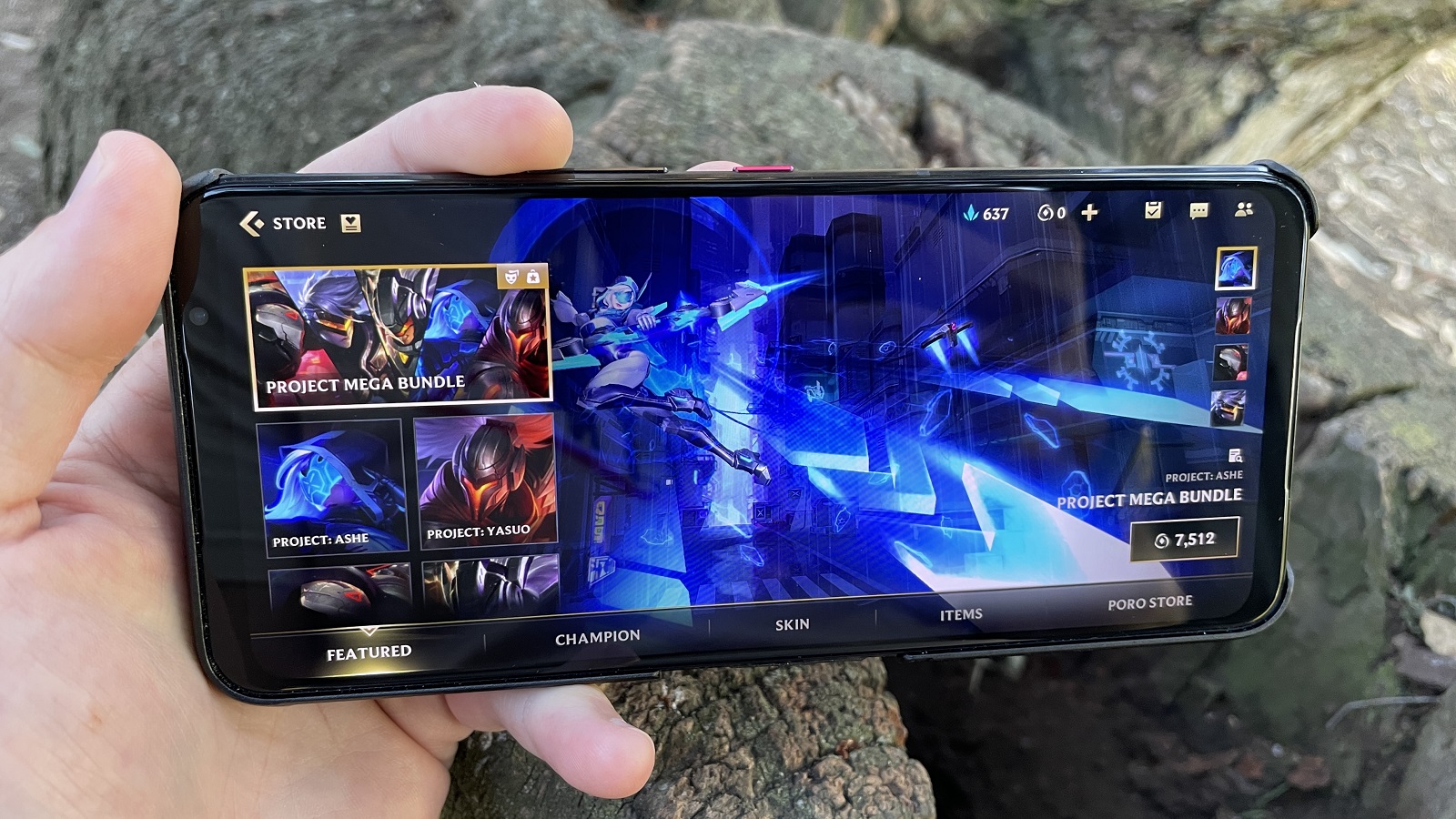Wild Rift beta is live in the US: here's how League of Legends Mobile is to play
League of Legends mobile, called Wild Rift, is live in beta in the US now

League of Legends’ mobile version, Wild Rift, is out in beta in the US and the Americas right now, and we got an early look at the highly-anticipated smartphone game. So how does it compare to the desktop version?
A Wild Rift general open beta started rolling out in select countries and regions in 2020, which finally reached players in the Americas on March 29. You can play it now on most smartphones – specifically, any Android phone with a 4-core 1.5Ghz chipset and 4GB of RAM and, for iOS phones, anything newer than an iPhone 6 Plus.
Players will find a mobile game that’s broadly like its desktop version: you’ll still take control of one champion with four teammates and move down a three-lane map to take on enemy champions, minions, and towers in a 5x5 match. Jungling, buying items, and last-hitting are still there – just slightly different to play on the small screen.
How many Wild Rift champions are there?
What are Wild Rift touch controls like?
How are Wild Rift items different?
Does Wild Rift have every League of Legends game mode?
How will Wild Rift progression work?
What are Wild Rift microtransactions like?
Can I port over anything from my desktop League account, like skins?
Will Wild Rift have unique champions or skins?
Will there be Wild Rift events?
Will there be a Wild Rift battle pass?
Is there voice chat?
Can I play with poor phone signal?
What are the Wild Rift phone requirements?
How will Riot curb toxicity on Wild Rift?
Can you use controllers with Wild Rift?
Will Wild Rift have a console version?
Will there be official Wild Rift esports support?
Obviously, most of the differences are due to playing on the small screen: touch controls mean changes to some champions, the map is smaller to encourage shorter matches, and several other less-consequential aspects have been tweaked. One quick note: all these changes have been made for smartphone screens, but Riot has confirmed that Wild Rift is coming to consoles in the future (release date TBD) along with cross-play between platforms, so the same tweaks on League gameplay will come in the console version.
Much has been preserved about the game that has dominated esports for over a decade, and we’ll walk through our initial impressions below. Have a specific question? We’ve answered some further into the article, but click one of the jump links on the side to head straight to them.

Initial impressions: what Wild Rift is like to play
If you’ve played ‘twin stick’ mobile games before, Wild Rift will be familiar to control: put your left thumb anywhere on the left half of the screen and drag it to move your champion, then tap any of the buttons on the right half of the screen to attack or use abilities. All in all, it’s a simple setup – and like desktop League, requires some practice to get familiar with which ability is linked to which icon.
Frankly, learning the ropes of the button layout isn’t too dissimilar from getting a handle on your broad toolbox in desktop League. There’s movement and healing abilities, as well as two buttons on either side of the large attack button to set attacks to prioritize towers or minions.
Sign up for breaking news, reviews, opinion, top tech deals, and more.

The latter is probably what veteran League players will struggle with most: targeting. In lieu of a very precise mouse, Wild Rift has a dynamic priority targeting system. When you encounter a group of enemies, the one your hero will target has a gold ring around it – touch your attack button to start hitting that foe, or tap-and-drag to manually select a different enemy by moving a yellow line emanating from your champion until the ring encircles the thing you want to attack.

It takes a little getting used to, but it’s a pretty intuitive solution, albeit one that will never be as precise as a mouse. Abilities piggyback off this targeting method, too, and tapping an ability button automatically fires it at your current ringed enemy. Of course, you can tap-and-drag the ability button to manually target it via a lit arrow signifying the pathway it’ll take – just let go of the button to fire. Finally, you can optionally add hero portraits to the UI to tap for quick attack and ability targeting.
(If this is confusing, don't worry – Wild Rift has its own set of tutorials to walk you through the new touch controls and other basic game concepts...and you'll get rewarded in-game currency for completing them, too.)
That makes it a bit tougher to last-hit everything, so you’ll still get some gold for laning, though not nearly as much as if you’d made the killing blow. To make it easier on players, enemy minion health bars will glow white when one basic attack from your champion will kill.
Keeping track of what’s happening elsewhere will take a bit of time, too, though desktop League vets should be able to read the mini-map just fine. Without a mouse, scanning the map is tough, so there are some adjustments to make up for it – like a picture-in-picture that pops up to show the path of any long-range or global ultimate abilities.
The changes to the Summoner’s Rift map are worth noting: it’s smaller, with condensed jungling and changes to towers – for instance, the end-of-lane tower and inhibitor have been combined, and there are no towers protecting the nexus, which itself now attacks enemies.

Speaking of the map, it’s now mirrored and always oriented the same to the player - you’ll start on the bottom left with the opponent’s spawn and nexus in the top right, every time. Why? Because otherwise your left movement thumb would get in the way of where you’re moving if you started in the top-right. That means ‘top and bottom’ are no longer helpful terms – the game has renamed them Solo and Duo lanes, respectively, and always refers to them thus.
Buying items might be cumbersome for experienced players, but it’s nice for beginners to have automatically-suggested items pop up below the mini-map whenever they return to spawn. They’re largely the same selection of items, just tweaked a bit.
Those are our first impressions – keep reading for answers to specific questions regarding how Wild Rift has adapted classic League gameplay to smartphones.

How many Wild Rift champions are there?
The Wild Rift beta currently has 61 champions, with plans to add up to two per month in releases related to themed events. Given desktop League has 156 champions, Wild Rift has a ways to go before reaching parity.
Wild Rift has the same champions as desktop League of Legends, though their abilities have been altered to accommodate touch controls and mobile gameplay. Passive abilities have been largely removed, like Vye’s dancing blows, for instance – a change Riot made to avoid having ‘dead’ buttons on screen for abilities that can’t be activated..
Riot Games has started the Wild Rift roster with champions that are most suited for mobile play. But the developers are also listening to fans: given the roster is heavy on humanoid champions, the next five to come are all bestial (Galio, Rammus, Kha’zix, Rengar, and Renekton, who will be released in April and May).
Like in desktop League, you can unlock champions via microtransactions, but none will be exclusive to real-money purchases – you’ll be able to earn every single one via in-game generated currency. New players will be given plenty of champions early in the progression system to grow their collection.
For videos on every champion added to Wild Rift, check the League of Legends: Wild Rift YouTube channel.
What are Wild Rift touch controls like?
Similar to other MOBA-style mobile games, Wild Rift uses a touch control interface split between a floating movement d-pad on the left half of the screen (tap anywhere and it appears under your thumb) and a series of buttons on the right half – a large one for general attack with four smaller ones for abilities fanned around it, with buttons to activate items and teleport back to base radiating further out.
Without the precision of a mouse, Wild Rift uses a ‘priority’ system to automatically target enemies with attacks and abilities – you’ll see this as a glowing ring around what your hero will target if you just tap attack or ability buttons. You can change this by tapping and dragging the attack button (the glowing ring will shift targets), and by default, your abilities will target the last enemy you attacked - but you can also cycle through different priorities (minion, champion, tower) via a small contextual button on the right side.
And yes, you can manually target skill-shot abilities: just tap-and-drag from the ability button outward in a direction and a bright-colored arrow will unfurl out from your champion showing the pathway of the ability – just release the button to fire.
There’s another couple tweaks for ultimate abilities: if it travels across big sections of the map, tapping-and-dragging will show a bright-colored arrow leading from the champion on the battlefield and the mini-map to give you an idea where it’s going. Fire away and a picture-in-picture window will pop up to show where the ultimate lands, giving players vision and, of course, the satisfaction of seeing a kill across the map.
How are Wild Rift items different?
Items are largely similar to their desktop counterparts. You’ll still buy them from the shop at spawn, though now the game will pop-up buttons below the minimap for suggested items to buy based on your build.
Items are now limited to two ranks, with the their tier reserved for enchantments. This allows different kinds of heroes to pick up abilities previously excluded from their roles: for instance, supports will be able to pick up Zhonya’s Hourglass, Riot developers suggested.
Does Wild Rift have every League of Legends game mode?
No, the Wild Rift beta doesn’t currently have any of League’s popular game alternate game modes – though the fan-favorite All Random, All Mid (ARAM) will be tested for brief periods in April, and may return for further testing sometime later in 2021.
Wild Rift’s ARAM matches will be slightly different, too: matches will last around 12 minutes, there’s a new summoner spell (Mark-Dash), and you can reroll champions, but there aren’t any loadouts or balance yet.
How will Wild Rift progression work?
Wild Rift has a very similar level progression system to desktop League. Players will get free champions with for each of the first ten or so levels, after which the rewards become sparser. No, you won’t be able to carry over your desktop League levels – players have to start from scratch on Wild Rift, though Riot is giving out extra rewards to players who join the beta late (like anyone in the Americas).

What are Wild Rift microtransactions like?
Wild Rift has its own in-game currency, Blue Motes (similar to Blue Essence in the desktop League), which is used to buy new champions, skins, and other cosmetics. Players earn Blue Motes after gaining enough experience to gain a level, and for completing challenges. You can also buy items and champions using real money in exchange for another in-game currency, Wild Cores – but every champion will be buyable with Blue Motes, too.
Keep in mind that Riot will eventually reset everyone’s account when the game exits beta and has its full launch – but the studio will compensate players who spent real money on in-game items.
Can I port over anything from my desktop League account, like skins?
No, you won’t be able to use skins you’ve acquired on deskstop League in Wild Rift – you’ll have to start your collection over. Riot may hold events or promotions with rewards for both versions of the game down the line, however.
Will Wild Rift have unique champions or skins?
The Wild Rift team is not currently planning to release a champion that won’t be on the desktop League version – frankly, they have their hands full expanding the current 61-champion lineup to catch up to desktop League’s 156-champion roster. All champions can be earned without spending real money.
Wild Rift will have skins exclusive to the mobile version, however. The first unique skinline is Stargazer, which will come in the weeks following the release of the next patch (2.2) and will include skins for Kamille, Twisted Fate, and Soraka.
Will there be Wild Rift events?
Yes, Wild Rift will have regular events, just like desktop League, with rewards and new champions themed to it. The next event, Masters of the Hunt, will introduce new gameplay in the form of Nemesis Duels, which are in-universe lore rivalries between characters that will have optional in-match events where players are challenged into 1v1 duels.
Riot does seem to be listening to fans during the beta: since so many champions in the current lineup are humanoid, the next five to be released during Masters of the Hunt are all bestial. Expect Galio, Rammus, Kha’zix, Rengar, and Renekton to come out starting in April and rolling into May.
Will there be a Wild Rift battle pass?
Yes, Wild Rift will have its own ‘battle pass’ called the Wild Pass, which is rolling out during the game's second ranked season in April. It will have a free tier as well as the paid Wild Pass Elite that will cost $6 per month (around £4/AU$8). It’ll work just like other battle passes, offering rewards along a level track, with more frequent bonuses for the paid tier.
Players can upgrade at any time to earn the paid-track rewards. These will include skins like God-King Darius, Blood Moon Kennen, Corgi Corki, Draven Draven, and Scorched Earth Renekton – some of which may be exclusive to mobile, like Techsplorer Jax, the reward for reaching level 50 on the inaugural Wild Pass.
Is there voice chat?
Yes, but only for pre-made teams of friends. You can’t voice chat with strangers on your team in a match – you’ll have to rely on emotes and premade voice lines to communicate with randos. There are a trio of buttons on the top-right of the screen while in a match that alert your team to Danger, Away, and TK.
Why not have voice chat on by default? Riot believes voice chat can be amazing for teamplay and coordination but they also want to avoid any toxic scenarios that can arise from voice chat – so it’s restricted to pre-made teams from users on your friends list, and it’s opt-in anyway.
Can I play with poor phone signal?
Yes, the Wild Rift team has worked on keeping the game playable at low signal, and have seen users playing on old 2G networks:
“We're really cognizant that cellphone internet can really differ depending on your location and provider—it's always going to be a battle, so we're constantly monitoring and looking for ways to deliver a reliable and stable service while holding ISPs and mobile providers accountable as well," Dawer Jung, operator of Live Operations on Wild Rift, told TechRadar.
"It's hard to put a single number against connection speeds as everyone's situation differs (you could live alone on Wi-Fi, or with 5 other people), but we’ve optimized Wild Rift to a point at which very low bandwidth connections can still play the game reliably," Jung said. "We have players successfully playing on old 2G networks, for example.”
What are the Wild Rift phone requirements?
The Wild Rift minimum spec for Android phones is: a 4-core CPU of 1.5Ghz (32 and 64-bit) or faster, at least 1.5GB RAM, and a display with HD (1280x720) resolution.
The Wild Rift minimum spec for iOS is the iPhone 6 Plus and newer phones.
"We want to ensure players have a good experience playing Wild Rift on all supported devices, and we think it’s super important for Wild Rift to support a very wide range of them," Trent Campbell, Principal Technical Product Manager on Wild Rift, told TechRadar.
So what will change for players on low-end vs. high-end devices?
"For players using high-end devices like the iPhone 12, we want to wow them with incredible visuals and animations, but also ensure that the game is as accessible as it can be for those that don’t have access to high-end phones," Campbell said. "On devices like the iPhone 6S (our minimum spec on iOS), our data shows a consistent framerate of near 30fps, and players have the option to change graphic quality settings to match their needs. We think the game still looks and feels great at the lowest graphics setting!"
How will Riot curb toxicity on Wild Rift?
Limiting voice chat to friends list-arranged parties (and ostensibly keep randos from spewing vitriol at each other) is one way Riot is intentionally trying to combat toxicity. They’re also planning reporting systems to hand out punishments for potential abuses of other in-game communication systems like excessive use of pings.
But Riot has other tweaks it's testing – proactive ones, like Position Preference (seen in the video above), allowing players to choose their preference of a match’s five roles (Solo, Duo, Mid, Support, Jungle) and ideally giving them their choice more often than the desktop League version’s 'pick three of five' role preference system.
Can you use controllers with Wild Rift?
Yes, but only if you map the controls yourself. Riot didn’t build in any official support for controllers – their initial testing was, by Riot’s description, a “difficult and painful experience” given how widely third-party controllers differ. They don’t expect many mobile players to use controllers, so we wouldn’t expect there to be a distinct advantage.
Will Wild Rift have a console version?
Yes, and Riot is developing a Wild Rift console version, plans to build in cross-play between console and mobile. There’s no Wild Rift console release date yet, nor even an idea when it’s coming.
But remember that controller question? Given the Wild Rift team’s early work building a version for console, the team claims the game can be played just fine on controllers, hopefully suggesting there won’t be such a performance imbalance when cross-play opens up play between console and mobile players – but that’s a far-off date anyway.
Will there be official Wild Rift esports support?
Yes, Riot's official LoL Esports arm committed to supporting Wild Rift Esports in early January, as GamingonPhone reported. In fact, Wild Rift's first 2021 season saw official esports competition between teams in Southeast Asia, where the open beta has already been live for months, with smaller competitive events in March and location-specific tournaments planned for April that will grow into regional showdowns to showcase the best players around, per a LoL Esports blog post.
Mobile gamers, it’s your time to shine! Today we are announcing our commitment to bring League of Legends: Wild Rift Esports to players around the world. pic.twitter.com/epE2vXHfwNJanuary 8, 2021
In the blog post, Riot committed to bringing Wild Rift Esports global. Given esports teams are starting to form Wild Rift rosters, per GamingonPhone, we could see more organization and tournaments in other regions as the scene grows over 2021.
- Stay on top of tech news with the TechRadar newsletter

David is now a mobile reporter at Cnet. Formerly Mobile Editor, US for TechRadar, he covered phones, tablets, and wearables. He still thinks the iPhone 4 is the best-looking smartphone ever made. He's most interested in technology, gaming and culture – and where they overlap and change our lives. His current beat explores how our on-the-go existence is affected by new gadgets, carrier coverage expansions, and corporate strategy shifts.